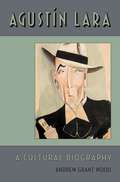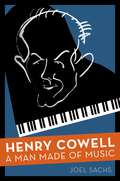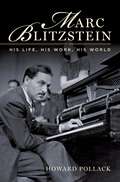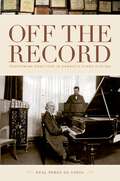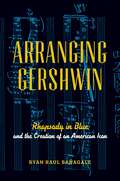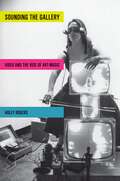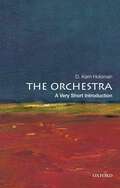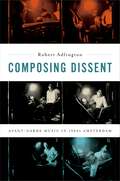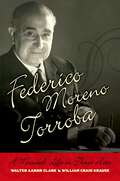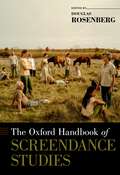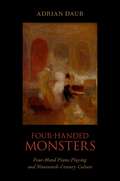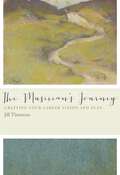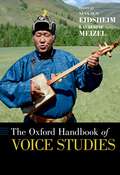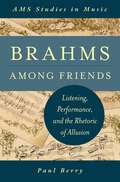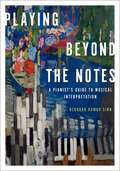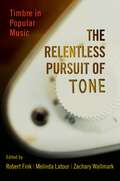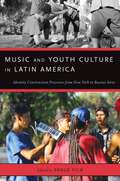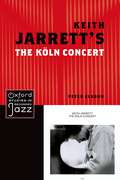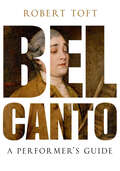- Table View
- List View
Agustin Lara: A Cultural Biography (Currents in Latin American and Iberian Music)
by Andrew Grant WoodFew Mexican musicians in the twentieth century achieved as much notoriety or had such an international impact as the popular singer and songwriter Agustín Lara (1897-1970). Widely known as "el flaco de oro" ("the Golden Skinny"), this remarkably thin fellow was prolific across the genres of bolero, ballad, and folk. His most beloved "Granada", a song so enduring that it has been covered by the likes of Mario Lanza, Frank Sinatra, and Placido Domingo, is today a standard in the vocal repertory. However, there exists very little biographical literature on Lara in English. In Agustín Lara: A Cultural Biography, author Andrew Wood's informed and informative placement of Lara's work in a broader cultural context presents a rich and comprehensive reading of the life of this significant musical figure. Lara's career as a media celebrity as well as musician provides an excellent window on Mexican society in the mid-twentieth century and on popular culture in Latin America. Wood also delves into Lara's music itself, bringing to light how the composer's work unites a number of important currents in Latin music of his day, particularly the bolero. With close musicological focus and in-depth cultural analysis riding alongside the biographical narrative, Agustin Lara: A Cultural Biography is a welcome read to aficionados and performers of Latin American musics, as well as a valuable addition to the study of modern Mexican music and Latin American popular culture as a whole.
Henry Cowell: A Man Made of Music
by Joel SachsJoel Sachs offers the first complete biography of one of the most influential figures in twentieth-century American music. Henry Cowell, a major musical innovator of the first half of the century, left a rich body of compositions spanning a wide range of styles. But as Sachs shows, Cowell's legacy extends far beyond his music. He worked tirelessly to create organizations such as the highly influential New Music Quarterly, New Music Recordings, and the Pan-American Association of Composers, through which great talents like Ruth Crawford Seeger and Charles Ives first became known in the US and abroad. As one of the first Western advocates for World Music, he used lectures, articles, and recordings to bring other musical cultures to myriad listeners and students including John Cage and Lou Harrison, who attributed their life work to Cowell's influence. Finally, Sachs describes the tragedy of Cowell's life, being sentenced to fifteen years in San Quentin -- of which he served four -- after pleading guilty to a morals charge that even the prosecutor felt was trivial. Providing a wealth of insight into Cowell's ideas and philosophy, Joel Sachs lays out a much-needed perspective on one of the giants of twentieth-century American music.
Marc Blitzstein: His Life, His Work, His World
by Howard PollackA composer and lyricist of enormous innovation and influence, Marc Blitzstein remains one of the most versatile and fascinating figures in the history of American music, his creative output running the gamut from films scores and Broadway operas to art songs and chamber pieces. A prominent leftist and social maverick, Blitzstein constantly pushed the boundaries of convention in mid-century America in both his work and his life. Award-winning music historian Howard Pollack's new biography covers Blitzstein's life in full, from his childhood in Philadelphia to his violent death in Martinique at age 58. The author describes how this student of contemporary luminaries Nadia Boulanger and Arnold Schoenberg became swept up in the stormy political atmosphere of the 1920s and 1930s and throughout his career walked the fine line between his formal training and his populist principles. Indeed, Blitzstein developed a unique sound that drew on everything contemporary, from the high modernism of Stravinsky and Hindemith to jazz and Broadway show tunes. Pollack captures the astonishing breadth of Blitzstein's work--from provocative operas like The Cradle Will Rock, No for an Answer, and Regina, to the wartime Airborne Symphony composed during his years in service, to lesser known ballets, film scores, and stage works. A courageous artist, Blitzstein translated Bertolt Brecht and Kurt Weill's The Threepenny Opera during the heyday of McCarthyism and the red scare, and turned it into an off-Broadway sensation, its "Mack the Knife" becoming one of the era's biggest hits. Beautifully written, drawing on new interviews with friends and family of the composer, and making extensive use of new archival and secondary sources, Marc Blitzstein presents the most complete biography of this important American artist.
Off the Record: Performing Practices in Romantic Piano Playing
by Neal Peres da CostaOff the Record is a revealing exploration of piano performing practices of the high Romantic era. Author and well-known keyboard player Neal Peres Da Costa bases his investigation on a range of early sound recordings (acoustic, piano roll and electric) that capture a generation of highly-esteemed pianists trained as far back as the mid-nineteenth-century. Placing general practices of late nineteenth-century piano performance alongside evidence of the stylistic idiosyncrasies of legendary pianists such as Carl Reinecke (1824-1910), Theodor Leschetizky (1830-1915), Camille Saint-Saëns (1838-1921) and Johannes Brahms (1833-1897), he examines prevalent techniques of the time--dislocation, unnotated arpeggiation, rhythmic alteration, tempo fluctuation--and unfolds the background and lineage of significant performer/pedagogues. Throughout, Peres Da Costa demonstrates that these early recordings do not simply capture the idiosyncrasies of aging musicians as has been commonly asserted, but in fact represent a range of established expressive practices of a lost age. An extensive collection of these fascinating and sometimes rare professional recordings of the Romantic age masters are available on a companion web site, and in addition, Peres Da Costa, himself a renowned period keyboardist, illustrates points made throughout the book with his own playing. Of essential value to student and professional pianists, historical musicologists of 19th and early 20th century performance practice, and also to the general music aficionado audience, Off the Record is an indispensable resource for scholarly research, performance inspiration, and listening enjoyment.
Arranging Gershwin: Rhapsody in Blue and the Creation of an American Icon
by Ryan BañagaleIn Arranging Gershwin, author Ryan Bañagale approaches George Gershwin's iconic piece Rhapsody in Blue not as a composition but as an arrangement -- a status it has in many ways held since its inception in 1924, yet one unconsidered until now. Shifting emphasis away from the notion of the Rhapsody as a static work by a single composer, Bañagale posits a broad vision of the piece that acknowledges the efforts of a variety of collaborators who shaped the Rhapsody as we know it today. Arranging Gershwin sheds new light on familiar musicians such as Leonard Bernstein and Duke Ellington, introduces lesser-known figures such as Ferde Grofé and Larry Adler, and remaps the terrain of this emblematic piece of American music. At the same time, it expands on existing approaches to the study of arrangements -- an emerging and insightful realm of American music studies -- as well as challenges existing and entrenched definitions of composer and composition. Based on a host of newly discovered manuscripts, the book significantly alters existing historical and cultural conceptions of the Rhapsody. With additional forays into visual media, including the commercial advertising of United Airlines and Woody Allen's Manhattan, it moreover exemplifies how arrangements have contributed not only to the iconicity of Gershwin and Rhapsody in Blue, but also to music-making in America -- its people, their pursuits, and their processes.
Arranging Gershwin: Rhapsody in Blue and the Creation of an American Icon
by Ryan BañagaleIn Arranging Gershwin, author Ryan Bañagale approaches George Gershwin's iconic piece Rhapsody in Blue not as a composition but as an arrangement -- a status it has in many ways held since its inception in 1924, yet one unconsidered until now. Shifting emphasis away from the notion of the Rhapsody as a static work by a single composer, Bañagale posits a broad vision of the piece that acknowledges the efforts of a variety of collaborators who shaped the Rhapsody as we know it today. Arranging Gershwin sheds new light on familiar musicians such as Leonard Bernstein and Duke Ellington, introduces lesser-known figures such as Ferde Grofé and Larry Adler, and remaps the terrain of this emblematic piece of American music. At the same time, it expands on existing approaches to the study of arrangements -- an emerging and insightful realm of American music studies -- as well as challenges existing and entrenched definitions of composer and composition. Based on a host of newly discovered manuscripts, the book significantly alters existing historical and cultural conceptions of the Rhapsody. With additional forays into visual media, including the commercial advertising of United Airlines and Woody Allen's Manhattan, it moreover exemplifies how arrangements have contributed not only to the iconicity of Gershwin and Rhapsody in Blue, but also to music-making in America -- its people, their pursuits, and their processes.
Sounding the Gallery: Video and the Rise of Art-Music (Oxford Music / Media)
by Holly RogersBecoming commercially available in the mid 1960s, video quickly became integral to the intense experimentalism of New York City's music and art scenes. The medium was able to record image and sound at the same time, which allowed composers to visualize their music and artists to sound their images. But as well as creating unprecedented forms of audiovisuality, video work also producedinteractive spaces that questioned conventional habits of music and art consumption. This book explores the first decade of creative video work, focusing on the ways in which video technology was used to dissolve the boundaries between art and music.
The Orchestra: Orchestra (Very Short Introductions)
by D. Kern HolomanThe Orchestra: A Very Short Introduction considers the structure, roots, and day-to-day functioning of the modern philharmonic society. Far from an anachronistic organization that cannot long survive, it is shown to be powerful political and social force, occupying critical positions in cultural diplomacy, national identity, and civic pride.
The Orchestra: A Very Short Introduction (Very Short Introductions)
by D. Kern HolomanThe Orchestra: A Very Short Introduction considers the structure, roots, and day-to-day functioning of the modern philharmonic society. Far from an anachronistic organization that cannot long survive, it is shown to be powerful political and social force, occupying critical positions in cultural diplomacy, national identity, and civic pride.
Composing Dissent: Avant-garde Music in 1960s Amsterdam
by Robert AdlingtonThe 1960s saw the emergence in the Netherlands of a generation of avant-garde musicians (including figures such as Louis Andriessen, Willem Breuker, Reinbert de Leeuw and Misha Mengelberg) who were to gain international standing and influence as composers, performers and teachers, and who had a defining impact upon Dutch musical life. Fundamental to their activities in the sixties was a pronounced commitment to social and political engagement. The lively culture of activism and dissent on the streets of Amsterdam prompted an array of vigorous responses from these musicians, including collaborations with countercultural and protest groups, campaigns and direct action against established musical institutions, new grassroots performing associations, political concerts, polemicising within musical works, and the advocacy of new, more 'democratic' relationships with both performers and audiences. These activities laid the basis for the unique new music scene that emerged in the Netherlands in the 1970s and which has been influential upon performers and composers worldwide. This book is the first sustained scholarly examination of this subject. It presents the Dutch experience as an exemplary case study in the complex and conflictual encounter of the musical avant-garde with the decade's currents of social change. The narrative is structured around a number of the decade's defining topoi: modernisation and 'the new'; anarchy; participation; politics; self-management; and popular music. Dutch avant-garde musicians engaged actively with each of these themes, but in so doing they found themselves faced with distinct and sometimes intractable challenges, caused by the chafing of their political and aesthetic commitments. In charting a broad chronological progress from the commencement of work on Peter Schat's Labyrint in 1961 to the premiere of Louis Andriessen's Volkslied in 1971, this book traces the successive attempts of Dutch avant-garde musicians to reconcile the era's evolving social agendas with their own adventurous musical practice.
Federico Moreno Torroba: A Musical Life in Three Acts (Currents in Latin American and Iberian Music)
by Walter Aaron Clark William Craig KrauseThe last of the Spanish Romantics, composer, conductor, and impresario Federico Moreno Torroba (1891-1982) left his mark on virtually every aspect of Spanish musical culture during a career that spanned six decades and saw tremendous political and cultural upheavals. After Falla, he was the most important and influential musician: in addition to his creative activities, he was President of the General Society of Authors and Editors and director of the Academy of Fine Arts. His enduring contributions as a composer include dozens of guitar works composed for Andrés Segovia and several highly successful zarzuelas, which remain in the repertoire today. Written by two leading experts in the field, Federico Moreno Torroba: A Musical Life in Three Acts explores not only his life and work, but also the relationship of his music to the cultural milieu in which he moved. It sheds particular light on the relationship of Torroba's music and the cultural politics of Francisco Franco's dictatorship (1939-75). Torroba came of age during a cultural renaissance that sought to reassert Spain's position as a unique cultural entity, and authors Walter A. Clark and William Krause demonstrate how his work can be understood as a personal, musical response to these aspirations. Clark and Krause argue that Torroba's decision to remain in Spain even during the years of Franco's dictatorship was based primarily not on political ideology but rather on an unwillingness to leave his native soil. Rather than abandon Spain to participate in the dynamic musical life abroad, he continued to compose music that reflected his conservative view of his national and personal heritage. The authors contend that this pursuit did not necessitate allegiance to a particular regime, but rather to the non-political exaltation of Spain's so-called "eternal tradition," or the culture and spirit that had endured throughout Spain's turbulent history. Following Franco's death in 1975, there was ambivalence towards figures like Torroba who had made their peace with the dictatorship and paid a heavy price in terms of their reputation among expatriates. Moreover, his very conservative musical style made him a target for the post-war avant-garde, which disdained his highly tonal and melodic españolismo. With the demise of high modernism, however, the time has come for this new, more distanced assessment of Torroba's contributions. Richly illustrated with photographs and musical examples, and with a helpful chronology and works list for reference, this biography brings a fresh perspective on this influential composer to Latin American and Iberian music scholars, performers, and lovers of Spanish music alike.
The Oxford Handbook of Screendance Studies (Oxford Handbooks)
The Oxford Handbook of Screendance Studies offers a full overview of the histories, practices, and critical and theoretical foundations of the rapidly changing landscape of screendance. Drawing on their practices, technologies, theories, and philosophies, scholars from the fields of dance, performance, visual art, cinema and media arts articulate the practice of screendance as an interdisciplinary, hybrid form that has yet to be correctly sited as an academic field worthy of critical investigation. Each chapter discusses and reframe current issues, as a means of promoting and enriching dialogue within the wider community of dance and the moving image. Topics addressed embrace politics of the body; agency, race, and gender in screendance; the relationship of choreography to image; constructs of space and time; representation and effacement; production and curatorial practice; and other areas of intersecting disciplines. The Oxford Handbook of Screendance Studies features newly-commissioned and original scholarship that will be essential reading for all those interested in the intersection of dance and the moving image, including film and video-makers, dance artists, screendance artists, academics and writers, producers, composers, as well as the wider interested public. It will become an invaluable resource for researchers and professionals in the field.
The Oxford Handbook of Screendance Studies (Oxford Handbooks)
by Douglas RosenbergThe Oxford Handbook of Screendance Studies offers a full overview of the histories, practices, and critical and theoretical foundations of the rapidly changing landscape of screendance. Drawing on their practices, technologies, theories, and philosophies, scholars from the fields of dance, performance, visual art, cinema and media arts articulate the practice of screendance as an interdisciplinary, hybrid form that has yet to be correctly sited as an academic field worthy of critical investigation. Each chapter discusses and reframe current issues, as a means of promoting and enriching dialogue within the wider community of dance and the moving image. Topics addressed embrace politics of the body; agency, race, and gender in screendance; the relationship of choreography to image; constructs of space and time; representation and effacement; production and curatorial practice; and other areas of intersecting disciplines. The Oxford Handbook of Screendance Studies features newly-commissioned and original scholarship that will be essential reading for all those interested in the intersection of dance and the moving image, including film and video-makers, dance artists, screendance artists, academics and writers, producers, composers, as well as the wider interested public. It will become an invaluable resource for researchers and professionals in the field.
Four-Handed Monsters: Four-Hand Piano Playing and Nineteenth-Century Culture
by Adrian DaubIn the course of the nineteenth century, four-hand piano playing emerged across Europe as a popular pastime of the well-heeled classes and of those looking to join them. Nary a canonic work of classical music that was not set for piano duo, nary a house that could afford not to invest in them. Duets echoed from the student bedsit to Buckingham Palace, resounded in schools and in hundreds of thousands of bourgeois parlors. Like no other musical phenomenon, it could cross national, social, and economic boundaries, bringing together poor students with the daughters of the bourgeoisie, crowned heads with penniless virtuosi, and the nineteenth century often regarded it with extreme suspicion for that very reason. Four-hand piano playing was often understood as a socially acceptable way of flirting, a flurry of hands that made touching, often of men and women, not just acceptable but necessary. But it also became something far more serious than that, a central institution of the home, mediating between inside and outside, family and society, labor and leisure, nature and nurture. And writers, composers, musicians, philosophers, journalists, pamphleteers and painters took note: in the art, literature, and philosophy of the age, four-hand playing emerged as a common motif, something that allowed them to interrogate the very nature of the self, the family, the community and the state. In the four hands rushing up and down the same keyboard the nineteenth century espied, or thought to espy, an astonishing array of things. Four-Handed Monsters tells not only the story of that practice, but also the story of the astonishing array of things the nineteenth century read into it.
Four-Handed Monsters: Four-Hand Piano Playing and Nineteenth-Century Culture
by Adrian DaubIn the course of the nineteenth century, four-hand piano playing emerged across Europe as a popular pastime of the well-heeled classes and of those looking to join them. Nary a canonic work of classical music that was not set for piano duo, nary a house that could afford not to invest in them. Duets echoed from the student bedsit to Buckingham Palace, resounded in schools and in hundreds of thousands of bourgeois parlors. Like no other musical phenomenon, it could cross national, social, and economic boundaries, bringing together poor students with the daughters of the bourgeoisie, crowned heads with penniless virtuosi, and the nineteenth century often regarded it with extreme suspicion for that very reason. Four-hand piano playing was often understood as a socially acceptable way of flirting, a flurry of hands that made touching, often of men and women, not just acceptable but necessary. But it also became something far more serious than that, a central institution of the home, mediating between inside and outside, family and society, labor and leisure, nature and nurture. And writers, composers, musicians, philosophers, journalists, pamphleteers and painters took note: in the art, literature, and philosophy of the age, four-hand playing emerged as a common motif, something that allowed them to interrogate the very nature of the self, the family, the community and the state. In the four hands rushing up and down the same keyboard the nineteenth century espied, or thought to espy, an astonishing array of things. Four-Handed Monsters tells not only the story of that practice, but also the story of the astonishing array of things the nineteenth century read into it.
The Musician's Journey: Crafting Your Career Vision and Plan
by Dr. Jill TimmonsThe Musician's Journey escorts musicians, performing artists, music teachers, and advanced music students along the road toward a successful career, offering a vast array of resources to guide them from envisioning the process to achieving the practical details. Jill Timmons provides key tools throughout the journey, from sources as diverse as the world of myth to current brain research, which illuminate compelling real-world examples of music entrepreneurs who forged their own paths to success. Included are chapters on careers in higher education; guidance in how to develop a business plan; general tips on grant writing and financial development; a separate section exploring the stories of other successful musicians; and personal narrative taken from the author's work as a professional musician and consultant. The book includes an extensive bibliography of additional resources, and the companion website offers downloadable worksheets and questionnaires to help readers along their way.
The Oxford Handbook of Voice Studies (Oxford Handbooks)
More than 200 years after the first speaking machine, we are accustomed to voices that speak from any- and everywhere. We interact daily with voices that emit from house alarm systems, cars, telephones, and digital assistants, such as Alexa and Google Home. However, vocal events still have the capacity to raise age-old questions about the human, the animal, the machine, and the spiritual-or in non-metaphysical terms-questions about identity and authenticity. In The Oxford Handbook of Voice Studies, contributors look to the metaphorical voice as well as the clinical understanding of the vocal apparatus to answer the seemingly innocuous question: What is voice? From a range of disciplines including the humanities, biology, culture, and technology studies, contributors draw on the unique methodologies and values each has at hand to address the uses, meanings, practices, theories, methods, and sounds of the voice. Together, they assess the ways that discipline-specific, ontological, and epistemological assumptions of voice need to shift in order to take the findings of other fields into account. This Handbook thus enables a lively discussion as multifaceted and complex as the voice itself has proven to be.
The Oxford Handbook of Voice Studies (Oxford Handbooks)
by Nina Eidsheim Katherine MeizelMore than 200 years after the first speaking machine, we are accustomed to voices that speak from any- and everywhere. We interact daily with voices that emit from house alarm systems, cars, telephones, and digital assistants, such as Alexa and Google Home. However, vocal events still have the capacity to raise age-old questions about the human, the animal, the machine, and the spiritual-or in non-metaphysical terms-questions about identity and authenticity. In The Oxford Handbook of Voice Studies, contributors look to the metaphorical voice as well as the clinical understanding of the vocal apparatus to answer the seemingly innocuous question: What is voice? From a range of disciplines including the humanities, biology, culture, and technology studies, contributors draw on the unique methodologies and values each has at hand to address the uses, meanings, practices, theories, methods, and sounds of the voice. Together, they assess the ways that discipline-specific, ontological, and epistemological assumptions of voice need to shift in order to take the findings of other fields into account. This Handbook thus enables a lively discussion as multifaceted and complex as the voice itself has proven to be.
Brahms Among Friends: Listening, Performance, and the Rhetoric of Allusion (AMS Studies in Music)
by Paul BerryBrahms Among Friends identifies patterns of listening, performance, and composition among close friends of Johannes Brahms and explores how those patterns informed the creation and reception of his music in the intimate genres of song, sonata, trio, and piano miniature. Among the tangled threads of counterpoint and circumstance that bound Brahms to his acquaintances was the technique of allusive musical borrowing, whereby a brief passage from a familiar work was drawn into the fabric of a new composition. For the specific listeners whose habits of mind and musicianship he knew best, allusive borrowings could become rhetorically charged gestures, persuasively revising the meanings his music conveyed and the interpretive strategies it invited. Primary documents, original manuscripts, music-analytic comparison, and kinesthetic parameters experienced in the act of performance all work in tandem to support ten case studies in the interplay between Brahms's small-scale works and the women and men who encountered them before publication. Central characters include violinist Joseph Joachim, singers Amalie Joachim, Julius Stockhausen, and Agathe von Siebold, composers Heinrich and Elisabeth von Herzogenberg, and pianists Emma Engelmann and Clara Schumann. For these musicians and for the composer himself, Brahms's allusive music served a broad variety of emotional needs and interpersonal ends. Yet across diverse repertoire and interdisciplinary correlates ranging from ethnography to psychoanalysis, each case study furthers a single, underlying aim: to reconstruct the mutually dependent perspectives of historically situated agents and restore forgotten features of their communicative landscapes as bases for both musical and historical scrutiny.
Playing Beyond the Notes: A Pianist's Guide to Musical Interpretation
by Deborah Rambo SinnPlaying Beyond the Notes: A Pianist's Guide to Musical Interpretation demystifies the complex concepts of musical interpretation in Western tonal piano music by boiling it down to basic principles in an accessible writing style. Author and veteran piano instructor Deborah Rambo Sinn tackles a different interpretive principle, explaining clearly, for example, how to play effective ornaments and rubatos. As a whole, the book helps pianists understand concrete ways to apply interpretive concepts to their own playing and gives teachers practical ways to teach interpretation to their students. The book is illustrated with over 200 repertoire excerpts and supplemented by a companion website with over 100 audio recordings. Playing Beyond the Notes is essential reading for all performing pianists, independent piano teachers, and piano pedagogy students.
The Relentless Pursuit of Tone: Timbre in Popular Music
The Relentless Pursuit of Tone: Timbre in Popular Music assembles a broad spectrum of contemporary perspectives on how "sound" functions in an equally wide array of popular music. Ranging from the twang of country banjoes and the sheen of hip-hop strings to the crunch of amplified guitars and the thump of subwoofers on the dance floor, this volume bridges the gap between timbre, our name for the purely acoustic characteristics of sound waves, and tone, an emergent musical construct that straddles the borderline between the perceptual and the political. Essays engage with the entire history of popular music as recorded sound, from the 1930s to the present day, under four large categories. "Genre" asks how sonic signatures define musical identities and publics; "Voice" considers the most naturalized musical instrument, the human voice, as racial and gendered signifier, as property or likeness, and as raw material for algorithmic perfection through software; "Instrument" tells stories of the way some iconic pop music machines-guitars, strings, synthesizers-got (or lost) their distinctive sounds; "Production" then puts it all together, asking structural questions about what happens in a recording studio, what is produced (sonic cartoons? rockist authenticity? empty space?) and what it all might mean.
Music and Youth Culture in Latin America: Identity Construction Processes from New York to Buenos Aires (Currents in Latin American and Iberian Music)
by Pablo VilaMusic is one of the most distinctive cultural characteristics of Latin American countries. But, while many people in the United States and Europe are familiar with musical genres such as salsa, merengue, and reggaetón, the musical manifestations that young people listen to in most Latin American countries are much more varied than these commercially successful ones that have entered the American and European markets. Not only that, the young people themselves often have little in common with the stereotypical image of them that exists in the American imagination. Bridging this divide between perception and reality, Music and Youth Culture in Latin America brings together contributors from throughout Latin America and the US to examine the ways in which music is used to advance identity claims in several Latin American countries and among Latinos in the US. From young Latin American musicians who want to participate in the vibrant jazz scene of New York without losing their cultural roots, to Peruvian rockers who sing in their native language (Quechua) for the same reasons, to the young Cubans who use music to construct a post-communist social identification, this volume sheds new light on the complex ways in which music provides people from different countries and social sectors with both enjoyment and tools for understanding who they are in terms of nationality, region, race, ethnicity, class, gender, and migration status. Drawing on a vast array of fields including popular music studies, ethnomusicology, sociology, and history, Music and Youth Culture in Latin America is an illuminating read for anyone interested in Latin American music, culture, and society.
Keith Jarrett's The Koln Concert (Oxford Studies in Recorded Jazz)
by Peter ElsdonKeith Jarrett ranks among the most accomplished and influential pianists in jazz history. His The Köln Concert stands among the most important jazz recordings of the past four decades, not only because of the music on the record, but also because of the remarkable reception it has received from musicians and lay-listeners alike. Since the album's 1975 release, it has sold over three million copies: a remarkable achievement for any jazz record, but an unprecedented feat for a two-disc set of solo piano performances featuring no well-known songs. In Keith Jarrett's The Köln Concert, author Peter Elsdon seeks to uncover what it is about this recording, about Keith Jarrett's performance, that elicits such success. Recognizing The Köln Concert as a multi-faceted text, Elsdon engages with it musically, culturally, aesthetically, and historically in order to understand the concert and album as a means through which Jarrett articulated his own cultural and musical outlook, and establish himself as a serious artist. Through these explorations of the concert as text, of the recording and of the live performance, Keith Jarrett's The Köln Concert fills a major hole in jazz scholarship, and is essential reading for jazz scholars and musicians alike, as well as Keith Jarrett's many fans.
Bel Canto: A Performer's Guide
by Robert ToftBel canto, or 'beautiful singing,' remains one of the most elusive performance styles vocalists strive to master. During the eighteenth and early nineteenth centuries, composers routinely left the final shaping of recitatives, arias, and songs to performers, and singers treated scores freely so that inexpressively notated music could be turned into passionate declamation. In other words, vocalists saw their role more as one of re-creation than of simple interpretation. Familiarity with the range of strategies prominent singers of the past employed to unlock the eloquent expression hidden in scores enables modern performers to take a similar re-creative approach to enhancing the texts before them. In this first ever guide to bel canto, author Robert Toft provides singers with the tools they need not only to complete the creative process the composer began but also to bring scores to life in an historically-informed manner. Replete with illustrations based on excerpts from Italianate recitatives and arias by composers ranging from Handel to Rossini, the book offers discussions of the fundamental principles of expressive singing, each section including a practical application of the techniques involved. Drawing on a wealth of documents from the era, including treatises, scores, newspaper reviews, and letters, this book captures the breadth of practices singers used in the bel canto period. Complete with six scores (recitatives and/or arias) for performers to personalize through the old methods, and a companion website offering demonstrations of the principles involved, Bel Canto is an essential resource for any singer or vocal instructor wishing to explore and master historical techniques of interpretation and re-creation from the eighteenth and early nineteenth centuries.
